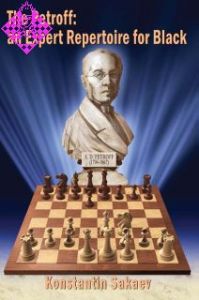Opening for White according to Anand - Vol. 10
190 Seiten, kartoniert, Chess Stars, 1. Auflage 2007
Dear readers,
You are holding in your hands book ten of the series "Opening for White According to Anand - 1.e4". It is devoted mostly to the Sveshnikov system, which is also popularly named as the Chelyabinsk variation. Naturally, it is worth remembering that the move 5...e 7- e 5 was played for the first time back in the year 1910 by great Lasker and this opening system changed its name numerous times throughout the years. The theory of that variation started developing rapidly during the 70ies of the last century, thanks to the efforts of Evgeny Sveshnikov, Gennadij Timoscenko and Alexander Panchenko (They all lived in the city of Chelyabinsk during those years.) and it seemed that the contemporary name should be most appropriate and logical.
In fact, starting from the seventies of the 20th century, the Chelyabinsk variation has never lost its popularity. The evaluation of that opening system has fluctuated between "100% reliable" to "almost refuted"; nevertheless, its theory has been developing intensely. Recently, the "anti-Chelyabinsk" systems - 3.Bb5 and 3.Nc3 are becoming top fashion and that only proves that the Chelyabinsk variation should be taken quite seriously. Practically all the best chess players of the world have contributed to the theory of that variation and the majority of them for both sides at that.
Well, if we follow strictly the classical principles, it would hardly be possible to classify Black's set-up as positionally correct. It looks like White's undisputed dominance over the d5-outpost should provide him with a stable advantage. Still, things are much more complex in practice. Amazingly enough, Black always finds resources for active counterplay based on some already typical strategical maneuvers around White's basic outpost on d5.
My work with this book was a rather complicated task by itself. My colleagues asked me often (sometimes ironically, sometimes with genuine interest) whether I had managed to refute the Chelyabinsk variation and when that refutation would be published? Here, I must admit: no, I have not refuted the Chelyabinsk variation. Frankly speaking, I have not even tried to do that. As far as my experience and my understanding of chess are concerned, Black's opening set-up has a sound strategical basis and it can never be refuted outright. Having that in mind, I decided to try something different and that was to systematize the amassed material and knowledge and to point out the most unpleasant lines for Black.
In the first part of our book, we have analyzed some lines, which do not belong exactly to the Chelyabinsk variation (That is some rare tries for Black on move five after 1.e4 c5 2.Nf3 Nc6 3.d4 cxd4 4.Nxd4 Nf6 5.Nc3.), as well as some not so popular sidelines of the Sveshnikov variation. All these opening systems have long been outside of the favourable recommendations of theory and quite deservedly so. We did not need to add anything principally new, but still White should play very precisely. I hope that we have pointed out clear-cut and logical ways of obtaining the advantage for White in the opening.
The second part of the book comprises in fact its focus in the aspect of common sense. It deals with positions, which are being tested practically every month at all possible levels of competition. I agree completely with the majority of the grandmasters, who consider that the greatest problems which Black must face nowadays in the Chelyabinsk variation are in the system 5...e5 6.Ndb5 d6 7.Bg5 a6 8.Na3 b5 9.Nd5 Be7 10.Bxf6 Bxf6 11.c3. I have not tried to change radically any theoretical evaluations, but I have managed to discover some new ideas and I have to tell you that Black will need to solve difficult problems after them.
A.Khalifman
14th World Chess Champion
| Gewicht | 320 g |
|---|---|
| Hersteller | Chess Stars |
| Breite | 14,4 cm |
| Höhe | 21,5 cm |
| Medium | Buch |
| Erscheinungsjahr | 2007 |
| Autor | Alexander Khalifman |
| Sprache | Englisch |
| Auflage | 1 |
| ISBN-13 | 9789548782647 |
| Seiten | 190 |
| Einband | kartoniert |
| Name | Chess Stars |
|---|---|
| Adresse | Complex "Geo Milev" BL. 248 Ap. 47 Sofia 1113 Bulgarien |
| Internet | www.chess-stars.com |
| semkov@chess-stars.com |
006 Preface
Part 1. Rare Lines
010 1 various without 5...e5
017 2 5...e5 6.Ndb5 d6 7.Bg5 various; 7...a6 8.Na3 without 8...Be6 and 8...b5
024 3 5...e5 6.Ndb5 d6 7.Bg5 a6 8.Na3 Be6
038 4 5...e5 6.Ndb5 d6 7.Bg5 a6 8.Na3 b5 9.Nd5 various; 9...Be7 10.Bxf6 gxf6
Part 2. Chelyabinsk Variation
065 5 various without 11...Ne7, 11...Bg5 and 11...0-0
073 6 11...Ne7
088 7 11...Bg5
106 8 11...0-0 12.Nc2 various without 12...Rb8 and 12...Bg5
113 9 11...0-0 12.Nc2 Rb8
128 10 11...0-0 12.Nc2 Bg5 13.a4 Rb8; 13...bxa4 14.Rxa4 without 14...a5
149 11 11...0-0 12.Nc2 Bg5 13.a4 bxa4 14.Rxa4 a5 15.Bc4 various
158 12 11...0-0 12.Nc2 Bg5 13.a4 bxa4 14.Rxa4 a5 15.Bc4 Bd7
175 13 11...0-0 12.Nc2 Bg5 13.a4 bxa4 14.Rxa4 a5 15.Bc4 Rb8
188Index of Variations
Wie übersetzt man den Titel der vorliegenden Reihe, die mittlerweile auf satte 10 Bände angewachsen ist, welche sich allesamt mit den Offenen oder Halboffenen Spielen beschäftigen?
Etwas Besseres als "Eine Eröffnung für Weiß nach 1.e4 à la Anand" ist Ihrem Rezensenten leider nicht eingefallen, wobei erschwerend hinzu kommt, dass der französische weibliche Artikel la im vorliegenden Kontext streng genommen gar nichts zu suchen hat. Sei's drum!
Im Grunde haben wir es bei Band 10 der Chess-Stars-Reihe mit einer Monographie über die sizilianische Sveschnikov-Variante zu tun: nicht weniger als 12 der vorhandenen 13 Kapitel beschäftigen sich nämlich mit den Stellungsbildern nach 1.e4 c5 2.Sf3 Sc6 3.d4 cxd4 4.Sxd4 Sf6 5.Sc3 e5 6.Sdb5. Komplette Partien werden Sie in unserem Buch vergeblich suchen, es handelt sich um ein reines Theoriewerk, das auf den einschlägigen fragmentarischen, bis ins tiefe Mittelspiel reichenden Zugfolgen basiert, die von Khalifman, seines Zeichens ehemaliger FIDE-Weltmeister, allerdings außerordentlich detailliert untersucht werden. Am Schluss eines jeden Kapitels subsummiert der Verfasser seine vorausgehenden Betrachtungen in Gestalt einer kurz gefassten Conclusion.
Die wenigsten der ausgewählten Fragmente, deren jüngste aus dem Jahr 2007 datieren und somit topaktuell sind, sind übrigens dem Schaffen Anands entsprungen, ganz im Gegenteil: wer sich die Mühe macht, den Namen der diversen Protagonisten nachzuspüren, wird in unserem Buch zwar etliche No-Name-Spieler, den aktuellen Schachweltmeister aus Indien aber nur ganz sporadisch antreffen.
Etikettenschwindel? Das Urteil sei ganz dem Leser überlassen. Band 10 ist vor allem eines: ein sehr gut gemachtes Repertoirebuch gegen ein seit Jahren außerordentlich beliebtes sizilianisches Verteidigungs- oder besser Gegenangriffssystem - und das ist eigentlich eine ganze Menge.
Mit freundlicher Genehmigung
E. Carl, Rochade Europa 2/2008
_____________________
Band 10 dieser epischen Reihe über Anands Eröffnungsrepertoire stellt eine der aufregendsten Eröffnungsvarianten der gesamten Schachtheorie in den Mittelpunkt des Geschehens, die Sveshnikov-Variante. Behandelt werden die Abspiele nach 1.e4 c5 2.Sf3 Sc6 3.d4 cxd4 4.Sxd4 Sf6 5.Sc3 e5 (andere Züge sind hier Sxd4, Dc7, Tb8, a6 die auch untersucht werden) 6.Sdb5 d6 7.Lg5 a6 8.Sa3 b5 (Le6 wird in einem Extra-Kapitel untersucht ) 9.Sd5 Le7 10.Lxf6 Lxf6 11.c3 und jetzt werden die drei Alternativen 11... 0-0, 11 ... Se7 und 11 ... Lg5 analysiert. Wobei ich anmerken muss, dass hier der Begriff "Analyse“ nicht mehr ganz zutrifft, eher wäre man geneigt zu sagen, Khalifman und sein Team (GM Landa, GM Makarov, GM Ovetchkin, IM Soloviev, IM Smikovski) zerlegen dieses Abspiel in sämtliche Bestandteile, ordnen alles fein säuberlich nebeneinander, suchen das Beste daraus hervor und setzen es wieder zusammen zu einem großmeisterlichen Ratgeber gegen die Sveshnikov-Variante. Es ist bestimmt nicht jedermanns Geschmack, endlose Variantenanhäufungen zu verfolgen und zuweilen den Überblick zu verlieren, aber ich glaube, dieses Buch ist auch nicht für den normalen durchschnittlichen Vereinsspieler geschrieben worden, sondern für Spieler jenseits der 2000er Marke und für Fernschachspieler. Das Buch beinhaltet komprimiertes Spezialwissen, dass, eingesetzt in unteren DWZ-Regionen, dem Versuch nahe kommt, "mit Atombomben auf Spatzen zu schießen“.
In der wichtigsten Variante des gesamten Abspiels kommt es nach den Zügen 1.e4 c5 2.Sf3 Sc6 3.d4 cxd4 4.Sxd4 Sf6 5.Sc3 e5 6.Sdb5 d6 7.Lg5 a6 8.Sa3 b5 9.Sd5 Le7 10.Lxf6 Lxf6 11.c3 0-0 12.Sc2 Lg5 13.a4 bxa4 14.Txa4 a5 15.Lc4 Tb8 16.b3 Kh8 17.Sce3! g6 18.0-0 Lh6 19.Dd3 f5 20.Td1 f4 21.Sc2 f3 22.g3 Ld7 23.Ta2 zu einer Stellung, die für die Bewertung der gesamten Sveshnikov-Variante von enormer Bedeutung ist. Khalifman schreibt dazu: Weiß muss an seinem Gebilde e4 und d5 festhalten und es scheint, als wäre dieser Plan etwas langsam, in Wirklichkeit ist es für Schwarz sehr unangenehm, die Verbindung zwischen seinen zwei Flanken ist unterbrochen. Die Varianten zeigen, dass das schwarze Gegenspiel nicht gefährlich für Weiß ist, bei sorgfältigem Spiel von Weiß wird Schwarz große Probleme mit seiner Bauernstruktur bekommen, Schwarz wird in diesem Abspiel nach Verbesserungen suchen müssen.
Ich habe die Varianten mit allen mir zur Verfügung stehenden Mitteln (Chessbase, Informator, NIC, Enzyklopädie, neueste Partien, Engines) überprüft und habe keine Fehler oder gar Schlampereien gefunden in den Analysen des Buches. Der Aussage Khalifmans zur obigen Hauptvariante ist also zu entnehmen, dass Weiß gegen die Sveshnikov-Variante durchaus etwas herausholen kann, vorausgesetzt natürlich, man kennt diese wichtigen Analysen!
Fazit:
Ausführliche und sorgfältige Großmeisteranalysen zu einem der wichtigsten Theoriegebilde unserer Zeit. Khalifman seziert vor den Augen des Lesers dieses System und dringt zum Kern der Stellung vor. Positionell gesehen ist die Sveshnikov-Variante natürlich anrüchig ( unter anderem die Felderschwäche d5 ), doch bisher konnte Schwarz dies durch energisches Gegenspiel ausgleichen. Mit diesem Buch und den darin enthaltenen Analysen wird es Schwarz zukünftig eindeutig schwerer fallen!
Zu empfehlen für Spieler ab ca. 2000 und ambitionierte Fernschachspieler.
Martin Rieger, Dezember 2008
-
 The Open Games for Black21,95 €
The Open Games for Black21,95 € -
 The Petroff:21,95 €
The Petroff:21,95 € -
 The Safest Grünfeld Reloaded22,95 €
The Safest Grünfeld Reloaded22,95 € -
 The Safest Scandinavian Reloaded21,95 €
The Safest Scandinavian Reloaded21,95 € - Mehr von Chess Stars




